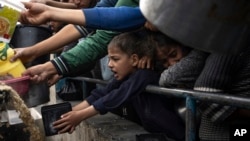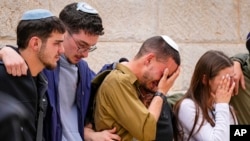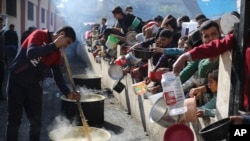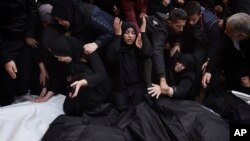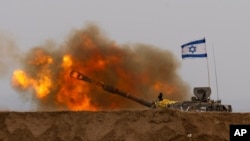Israeli forces widened their offensive in Gaza Friday as international efforts to mediate a cease-fire continued and the humanitarian crisis in the enclave escalated.
Residents in Gaza reported heavy shelling and air strikes in parts of northern Gaza. Air strikes were also reported in Khan Younis and Rafah, in the south. Israel’s military ordered residents of al-Bureij and surrounding communities in central Gaza, to move south immediately, an indication of a possible ground assault in the area.
The Hamas-run health ministry in Gaza says at least 20,000 Palestinians have been killed since Israel launched its attack on Gaza following the October 7 Hamas terror attack in Israel that killed about 1,200 people, with about 240 people taken hostage.
Nearly 2 million Palestinians have been displaced by Israel since then. The health ministry in Gaza reports that 390 Palestinians have been killed in the last two days.
The continued Israeli offensive comes amid diplomatic attempts secure a cessation of fighting in Gaza. A U.N. Security Council vote on terms for a cease-fire and conditions for a resumption of aid deliveries drafted by the United Arab Emirates, which had been delayed since Monday, was expected to be taken Friday.
The delay was due in part because of objections from the United States over some language the U.S. could not support. A revised draft Thursday showed changes, including dropping a call for “the urgent suspension of hostilities” to allow in aid.
However, U.S. Ambassador Linda Thomas-Greenfield said Thursday evening the U.S. is ready to vote in support of the amended resolution.
“It's a resolution that will bring humanitarian assistance to those in need,” she said.
Other proposed changes included altering language about establishing a United Nations monitoring mechanism that would inspect aid entering Gaza to make sure it is humanitarian in nature. The new proposed text called for the U.N. secretary-general to appoint a “senior humanitarian and reconstruction coordinator” who would then establish a U.N. mechanism for speeding aid deliveries into Gaza.
Thomas-Greenfield said the changes had support from Arab nations.
“The draft resolution is a very strong resolution that is fully supported by the Arab group, that provides them what they feel is needed to get humanitarian assistance on the ground,” she told reporters.
A vote was expected Friday, to give other council members time to consult their capitals about the changes.
The United Nations has said that even if sufficient humanitarian supplies were permitted into Gaza, security, fuel and disrupted communications would still make it difficult to deliver the supplies. It has called for an immediate humanitarian cease-fire.
Hunger rapidly rising
The anticipated aid vote will come at a critical time.
The Integrated Food Security Phase Classification initiative (IPC) said in a report Thursday that hostilities, “including bombardment, ground operations and besiegement of the entire population,” have caused “catastrophic levels” of acute food insecurity.
The U.N.-backed body that monitors global hunger and issues famine warnings warned that the entire population of Gaza — more than 2 million people — was at crisis levels or worse of hunger, and that the potential for famine was on the horizon within the next six months if the current situation and restricted aid access continued.
IPC said more than 1 in 4 households faced extreme hunger and a quarter of Gazans — 577,000 people — had exhausted their food supplies and faced catastrophic levels of hunger and starvation.
“WFP has warned of this coming catastrophe for weeks,” World Food Program Executive Director Cindy McCain said of the IPC’s findings. “Tragically, without the safe, consistent access we have been calling for, the situation is desperate, and no one in Gaza is safe from starvation.”
Israel says it is cooperating in allowing aid to enter Gaza. It opened the Kerem Shalom border crossing on Sunday for aid convoys to transit. The crossing is near the three borders of Israel, Gaza Strip and Egypt. The Israel Defense Forces says it is allowing brief tactical pauses in some areas of southern Gaza for civilians to get food and water.
The war, sparked by Hamas’ October 7 terror attack inside Israel that killed about 1,200 people and saw some 240 others taken hostage, has led to a dire humanitarian situation unfolding in Gaza, where the Hamas-run health ministry says 20,000 Palestinians have been killed. Nearly 2 million others have been displaced.
Intense fighting
Fighting intensified between Hamas and Israel on Thursday.
Heavy Israeli bombardments were reported in northern Gaza, and warplanes struck targets in central and southern parts of the enclave. Four people were reportedly killed in southern Gaza at the Rafah border crossing with Egypt, according to Hamas. Israel's military appeared to deny involvement, saying it was not familiar with the incident.
Ten weeks into the war, Hamas, a U.S.-designated terror organization, showed it still has the ability to launch rockets at the Jewish state, as sirens sounded in central Israel. The IDF posted maps showing rocket alarms stretching from Ashkelon, just north of the Gaza Strip, to the Tel Aviv area.
No casualties were reported as the country’s Iron Dome defense system intercepted the rockets.
Israel’s military also said Thursday that its forces had carried out attacks against 230 targets in Gaza during the past day.
Prime Minister Benjamin Netanyahu reiterated that his military would continue fighting until Hamas was eliminated and its remaining hostages were free.
VOA U.N. Correspondent Margaret Besheer contributed to this report. Some information came from The Associated Press, Agence France-Presse and Reuters.




